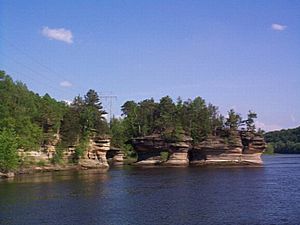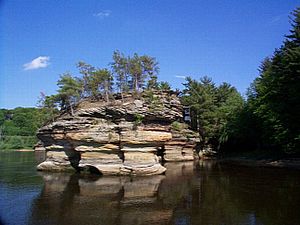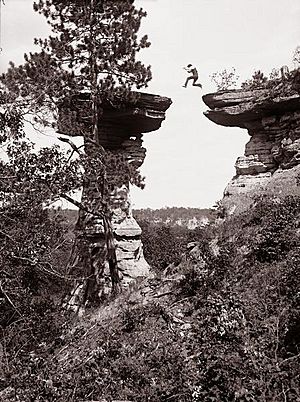Dells of the Wisconsin River facts for kids
The Dells of the Wisconsin River, often called the Wisconsin Dells, is an amazing 5-mile (8-kilometer) long gorge. It's located on the Wisconsin River in south-central Wisconsin, USA. The word "Dells" comes from a French word meaning "slab-like rocks."
This area is famous for its stunning natural beauty. You'll see unique Cambrian sandstone rock formations and cool side canyons. Some cliffs are over 100 feet (30 meters) tall! These areas are protected and not open to the public.
However, you can explore the rock formations by boat, which is a very popular activity. The nearby city of Wisconsin Dells is a busy spot for tourists. It has many theme parks, though these are separate from the river's natural features.
The Dells of the Wisconsin River is owned by the Wisconsin Department of Natural Resources. It became a special State Natural Area in 1994. This helps protect its unique environment.
Contents
How the Dells Were Formed
The Dells were created about 15,000 years ago during the last ice age. But the rocks themselves are much older! They formed around 510 to 520 million years ago in the Cambrian period. Back then, Wisconsin was covered by a shallow sea.
About 19,000 years ago, a huge glacier was near the Dells. But the Dells area itself was never covered by ice. It was part of a special place called the Driftless Area, which the glaciers missed.
As the glacier melted, it formed a giant body of water called Glacial Lake Wisconsin. This lake was as big as Great Salt Lake in Utah. It was also very deep, up to 150 feet (45 meters). An ice dam from the glacier held the lake back.
Eventually, this ice dam broke! A massive flood burst out, making the lake much shallower. This powerful flood carved out the deep, narrow gorges and the unusual rock formations you see today.
Plants and Animals of the Dells
The Dells area is home to many different kinds of plants. You can find oak and pine forests, along with open oak savannas. There are also unique plants that grow on the moist and dry cliffs.
The cliffs offer special places for plants to grow. Some of these plants are very rare in Wisconsin, including:
- Cliff cudweed (Gnaphalium obtusifolium var saxicola). This plant is found in only two places on Earth!
- Lapland azalea (Rhododendron lapponicum)
- Round-stemmed false foxglove (Agalinis gattingeri)
- Maidenhair spleenwort (Asplenium trichomanes)
- Fragrant fern (Dryopteris fragrans)
The Dells also has rare animals. You might spot six different kinds of dragonfly species, like the Royal river cruiser. There are also six rare types of mussels and many different kinds of birds.
A Look at History
The history of the Dells goes back thousands of years. Early Paleo-Indian people lived here, followed by other Native American groups. These included the Ho-Chunk, Sac, and Menominee peoples. They left behind interesting things like burial mounds, village sites, and rock art.
The Dells became very famous in 1886, thanks to a photographer named H. H. Bennett. He took the first "stop-action" photo of his son jumping onto a rock formation called Stand Rock. This picture helped show the world how amazing the Dells were.
Protecting the Dells
Today, the Dells area is owned by the Wisconsin Department of Natural Resources. In 1994, it was officially named a State Natural Area. This special status helps protect the unique natural features and wildlife of the Dells for everyone to enjoy.




